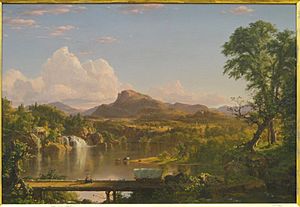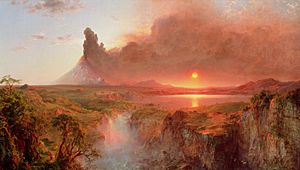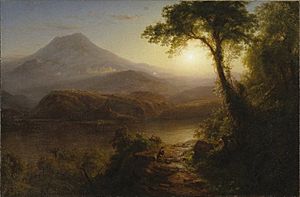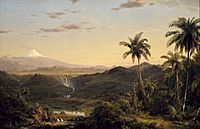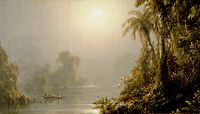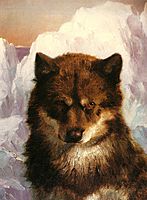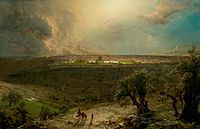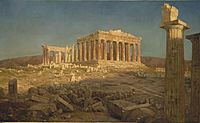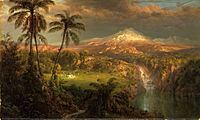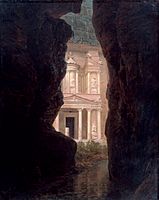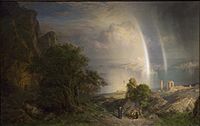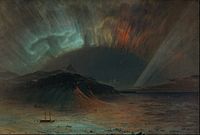Frederic Edwin Church facts for kids
Quick facts for kids
Frederic Edwin Church
|
|
|---|---|
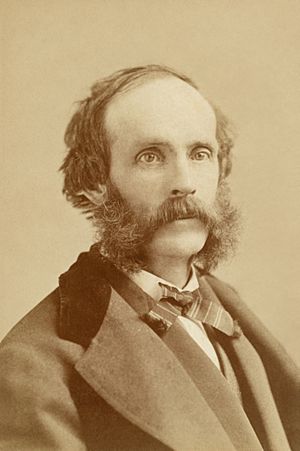
c. 1868 photograph by Napoleon Sarony
|
|
| Born | May 4, 1826 Hartford, Connecticut, U.S.
|
| Died | April 7, 1900 (aged 73) New York City, U.S.
|
| Known for | Landscape painting |
|
Notable work
|
Niagara, The Heart of the Andes |
| Movement | Hudson River School |
Frederic Edwin Church (born May 4, 1826 – died April 7, 1900) was an American landscape painter. He was born in Hartford, Connecticut. Church was a very important artist in the Hudson River School. This was a group of American painters who focused on landscapes.
He was famous for his large paintings of nature. These often showed mountains, waterfalls, and amazing sunsets. Church's art was known for its realistic details. He used dramatic light and wide, sweeping views. He would often show his biggest paintings one at a time in New York City. People would pay to see them and were often amazed. During his most famous time, he was one of the best-known painters in the United States.
Contents
Biography
Early Life and Learning
Frederic Edwin Church came from a very old American family. His family had been in Connecticut since the 1600s. Frederic was the son of Eliza and Joseph Church. His father was a successful silversmith and jeweler. He also worked in finance. Frederic's family was wealthy, which allowed him to follow his passion for art from a young age.
When he was 18, in 1844, Church became a student of Thomas Cole. Cole was a famous landscape artist in Catskill, New York. A family friend helped them meet. Church studied with Cole for two years. Everyone could see how talented he was. Cole even said Church had "the finest eye for drawing in the world."
During his time with Cole, Church traveled around New England and New York. He made many sketches of places like the Catskill Mountain House and Vermont. His first painting was sold in 1846 for $130. It showed a peaceful scene of nature.
In 1848, he became the youngest Associate of the National Academy of Design. This was a big honor for a young artist. The next year, he became a full member. He then started teaching his own students.
Art Style and What Inspired Him
In the early 1800s, a style called Romanticism was popular in Europe. It was a reaction against too much focus on logic and reason. Romantic artists often painted nature in a perfect way. They showed its beauty and grand scale. Church continued this tradition in his art. He painted nature as untouched and perfect. He used incredible detail in his work.
Church was part of the second generation of the Hudson River School. His teacher, Thomas Cole, started this art movement. Both Cole and Church were religious. Their beliefs influenced Church's early paintings. Hudson River School paintings focused on natural settings, especially the Catskill Mountains. They tried to capture the wild beauty of America that was quickly changing. Church's paintings of American landscapes showed the hopeful spirit of the United States in the mid-1800s.
A big influence on Church was Alexander von Humboldt. He was a Prussian explorer and scientist. Humboldt believed that science, nature, and spiritual ideas were all connected. He wrote a book called Kosmos. In it, he said artists were important for showing the diversity of nature. Church owned this book and was inspired by it.
Another important person for Church was the English art critic John Ruskin. In his book Modern Painters, Ruskin said landscape painters must pay close attention to every detail in nature. He believed artists should study every rock, cloud, and type of earth. But he also said artists needed to add their own feelings and imagination to create great art. Church's paintings were praised for their detail. However, some critics felt they sometimes lacked imagination.
Some of Church's paintings also showed elements of the Luminist style. Luminist art often has strong horizontal lines and smooth surfaces. This makes it seem like the painter's hand isn't visible. Paintings like Morning in the Tropics and Twilight in the Wilderness show this style. They have careful drawing and bright colors. But Church is not mainly known as a Luminist artist.
Career Highlights
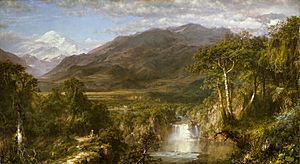
Church started his career painting scenes from New York and New England. These were typical of the Hudson River School. By 1850, he had settled in New York City. He showed his art in important places like the National Academy of Design.
His way of working involved making sketches outdoors. Then, he would create his finished paintings in his studio. At first, his style was similar to his teacher, Thomas Cole. But as he grew as an artist, Church's paintings became more detailed. His compositions were more daring, sometimes with dramatic light effects.
Church quickly became known as an artist who traveled a lot. He took early trips to places like the White Mountains and Niagara Falls. He also made two trips to South America in 1853 and 1857. He spent most of his time in Quito, Ecuador. He visited volcanoes and cities in what are now Colombia and Ecuador.
His first trip to South America was with a businessman named Cyrus West Field. Field hoped Church's paintings would help him find investors for his projects there. Church was inspired by Alexander von Humboldt's explorations of the continent. Humboldt had encouraged artists to paint the unique look of the Andes mountains. After his trips, Church painted many landscapes of Ecuador and the Andes. These include The Andes of Ecuador (1855) and The Heart of the Andes (1859).
The Heart of the Andes is Church's most famous painting. It combines many different natural features into one grand, ideal picture of nature. The painting was very large and full of tiny details. You could identify every plant and animal. It even showed different climate zones all at once.
Just like he did with his painting Niagara, Church showed The Heart of the Andes by itself in New York City in 1859. Thousands of people paid to see it. The painting was so big that its frame looked like a window looking out onto the Andes. People sat on benches to view it. Church even arranged the room so that light from above shone perfectly on the painting. It was an instant success. Church sold it for $10,000. At that time, it was the highest price ever paid for a painting by a living American artist.
Church also became friends with Dr. Isaac Israel Hayes, an explorer of the Arctic. This made Church interested in painting cold, icy places. In 1859, Church traveled to Newfoundland and Labrador. This journey was written about in a book. Soon after, Church's painting "The Icebergs" was shown.
By 1860, Church was the most famous American artist. He was successful both artistically and financially. He was a very rich man when he died in 1900.
In 1861, when the Civil War began, Church painted Our Banner in the Sky. He was inspired by a sunset with red, white, and blue colors. He believed it showed that "the heavens indicated their support for the United States." A print was made from the painting and sold to help the families of soldiers fighting for the Union.
In 1863, he was chosen as a Fellow of the American Academy of Arts and Sciences.
Family, Later Travels, and Olana
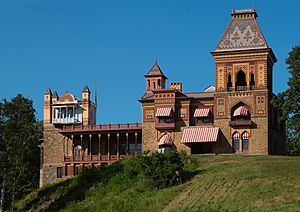
In 1860, Church bought a farm near Hudson, New York. He married Isabel Mortimer Carnes, whom he had met in New York. They started a family, but sadly, their two young children died in 1865 from an illness. Still very sad, Church, his wife, and a friend traveled to Jamaica. Church sketched, and Isabel collected ferns. They later had more children: Frederic Joseph, Theodore Winthrop, Louis Palmer, and Isabel Charlotte.
In late 1867, Church began his longest trip. He and his family traveled to Europe, then to Egypt. They spent four months in Beirut. In 1868, Church traveled by camel to the ancient city of Petra. There, he sketched the famous Al Khazneh tomb. This sketch later became an important painting called El Khasné, Petra (1874). They also visited Damascus and Baalbek. They sailed the Aegean Sea and stopped in Constantinople.
They spent the winter in Rome, Italy. Many American artists were there, and Church joined friends. While in Rome, he learned about fresco painting. He also collected paintings by "Old Masters." Europe didn't seem to interest Church as much as it did other American artists. He made a short trip to Athens, Greece, in 1869. He was amazed by the Parthenon and sketched it with great energy. The Churches returned home in June 1869.
Before this trip, Church bought land on a hilltop near his farm in Hudson. He loved the amazing views of the Hudson River and the Catskills. In 1870, he started building a mansion on this hilltop. It was inspired by Persian architecture. The family moved into their new home in the summer of 1872. This estate is now known as the Olana State Historic Site.
Church was very involved in designing his home. He even made his own architectural sketches. This unique building included many ideas he got from his travels. He spent much of his time in his later years working on Olana. He once wrote that he could make "more and better landscapes" by building roads and shaping the land at Olana than by painting in his studio.
Church had been very successful as an artist. But in his later years, an illness made it hard for him to paint. By 1876, he had rheumatoid arthritis. This made painting difficult. He eventually learned to paint with his left hand. He continued to create art, but at a slower pace. He also taught painting, just as Cole had taught him. In his later life, he often spent winters in Mexico.
Church spent a lot of time at Olana and in Mexico. This meant he was less connected to the art trends in New York City. His wife, Isabel, was ill for many years and died in 1899. Less than a year later, on April 7, 1900, Church also passed away at age 73. Frederic and Isabel were buried in Spring Grove Cemetery in Hartford, Connecticut.
Legacy
In the last years of Church's life, his fame faded. By the time he died in 1900, people were not very interested in his work. His paintings were seen as old-fashioned. They were thought to be too focused on small details.
However, his reputation began to improve. In 1945, an exhibition about the Hudson River School helped bring attention back to his art. The Metropolitan Museum of Art Bulletin also looked back at how The Heart of the Andes was first received.
In the 1960s, an art historian named David C. Huntington studied Church's work. He helped organize the first exhibition dedicated to Church since his death. Huntington realized that Church's home, Olana, was his greatest artwork. He led a two-year effort to save Olana when it was in danger of being destroyed. Thanks to his work, Olana became a State Historic Site.
Church's legacy was brought back to life. American museums started buying his paintings. In 1979, Church's The Icebergs sold for $2.5 million. This was a record-setting price for a work of art at the time. The next year, the National Gallery of Art held a big exhibition. It showed Church as the leading American painter of his time.
Church's paintings were bolder and grander than those of other artists. They captured the hopeful spirit of Americans. People at the time believed in the idea of manifest destiny. This was the idea that America was meant to expand across the continent. Art historian Barbara Novak said Church was like an artist who became the "public voice of a culture." He showed its beliefs and ideas.
Today, the Olana State Historic Site is managed by the New York State Office of Parks, Recreation and Historic Preservation. A private group called The Olana Partnership helps with its care and visitor services. In 1999, The Olana Partnership created the Frederic Church Award. This award honors people and groups who make great contributions to American art and culture.
Gallery
-
The Andes of Ecuador, 1855, Reynolda House Museum of American Art
-
Niagara,1857, Frederic Edwin Church, National Gallery of Art, Washington, DC.
-
Morning in the Tropics, ca. 1858, The Walters Art Museum, Baltimore
-
Twilight in the Wilderness, 1860, Cleveland Museum of Art
-
The Aegean Sea, c. 1877, Metropolitan Museum of Art
See also
 In Spanish: Frederic Edwin Church para niños
In Spanish: Frederic Edwin Church para niños


